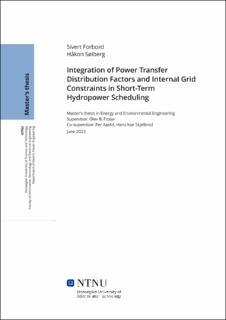| dc.contributor.advisor | Fosso, Olav B. | |
| dc.contributor.advisor | Skjelbred, Hans Ivar | |
| dc.contributor.advisor | Aaslid, Per | |
| dc.contributor.author | Sølberg, Håkon | |
| dc.contributor.author | Forbord, Sivert | |
| dc.date.accessioned | 2023-10-05T17:22:13Z | |
| dc.date.available | 2023-10-05T17:22:13Z | |
| dc.date.issued | 2023 | |
| dc.identifier | no.ntnu:inspera:146046472:59159481 | |
| dc.identifier.uri | https://hdl.handle.net/11250/3094651 | |
| dc.description.abstract | Med økende forbruk av elektrisk energi blir det avgjørende å maksimere utnyttelsen
av våre ressurser og infrastruktur. I et land som Norge innebærer dette effektiv bruk
av strømnettet og utnyttelse av vannet som er lagret i vannkraftreservoarer. Korttidsvannkraftplanlegging
(STHS) tar vanligvis ikke hensyn til begrensninger i strømnettet i
optimaliseringsprosessen. Denne avhandlingen har som mål å utforske implementeringen
av Power Transfer Distribution Factors (PTDF) i vannkraftplanlegging for å muliggjøre
optimalisering med hensyn til nettbegrensninger.
For å belyse bruksområdene til PTDF ble det gjennomført en serie optimaliseringer i
STHS-verktøyet SHOP, utviklet av SINTEF ER. En systemmodell som gjenskaper den
norske prissonen NO4 ble satt sammen, og en frittstående Python-modul ble utviklet for
å generere PTDF-faktorene. Resultatene viser forskjellige bruksområder for PTDF, blant
annet beregning av kraftflyt, håndheving av kraftflytbegrensninger, bruk i utfallsanalyse
og håndtering av flaskehalser.
Lærdom fra optimaliseringene ble brukt til å utforske ulike nivåer av PTDFimplementering
i markedsklareringen. Diskusjonen omfattet ulike tilnærminger,
inkludert nodeprising og soneprising med FBMC. Inkluderingen av nettbegrensninger
i markedsklareringen introduserer problemstillinger knyttet til markedsmakt. Det er
behov for økt samarbeid mellom nettselskaper og kraftprodusenter for å håndtere disse
utfordringene. Diskusjonen om PTDF-modulen anerkjente fordelene med å ha en
dedikert modul som er i stand til å generere begrensninger for optimaliseringsproblemet.
Potensialet for å inkludere utfallsanalyse og håndtering av flaskehalser i modulen er verdt
å nevne.
Konklusjonen er at bruk av Power Transfer Distribution Factors i korttidsvannkraftplanlegging
og i markedsklareringen har stort potensiale. Dette potensialet er
dog avhenging av at det etableres et system for å sikre et rettferdig kraftmarked. | |
| dc.description.abstract | With the growing electricity demand, maximizing the utilization of our resources and
infrastructure becomes crucial. In countries like Norway, this entails effectively utilizing
the transmission grid and harnessing the potential of water stored in hydropower reservoirs.
In Short-Term Hydro Scheduling (STHS), grid limitations are often not included
in the optimization process. This thesis aims to explore the implementation of Power
Transfer Distribution Factors (PTDF) in the STHS problem to enable grid-constrained
optimization.
To highlight the applications of PTDF, a series of optimizations were run in the STHS
tool SHOP, developed by SINTEF ER. A system model replicating the Norwegian
price zone NO4 was developed for the optimizations, and a standalone Python module
was designed to generate the PTDF factors. The optimization results showcase the
diverse applications of PTDF. These encompass power flow calculation, enforcing flow
restrictions, the utilization in contingency analysis and congestion management, and its
effectiveness in calculating power flows within specific sub-zones of the system.
Insights derived from the case studies were employed to explore different levels of PTDF
implementation in the electricity market clearing process. The discussion encompassed
various pricing approaches, including nodal pricing and zonal pricing with FBMC.
Including grid constraints in the market clearing algorithm introduces complexities
related to market manipulation and unfair market positions. Enhanced collaboration
between Transmission System Operators and power producers is needed to address these
challenges. The discussion on the PTDF module recognized the benefits of having a
dedicated module capable of generating constraints for the optimization problem. Apart
from generating PTDF, the module was also assessed for its potential to incorporate
contingency analysis and congestion management techniques.
In conclusion, utilizing Power Transfer Distribution Factors in STHS and in the market
clearing shows great promise. However, unlocking its full potential relies on establishing
a robust system to ensure a just and equitable power market. | |
| dc.language | eng | |
| dc.publisher | NTNU | |
| dc.title | Integration of Power Transfer Distribution Factors and Internal Grid Constraints in Short-Term Hydropower Scheduling | |
| dc.type | Master thesis | |
